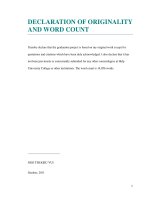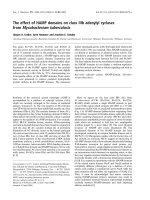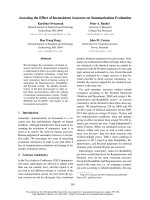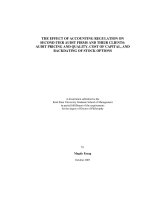The effect of ưomens education on fertility in vietnam
Bạn đang xem bản rút gọn của tài liệu. Xem và tải ngay bản đầy đủ của tài liệu tại đây (620.27 KB, 80 trang )
UNIVERSIT Y OF ECONOMIC
S HO CHI MINH CITY
VIETNAM
INSTIUTTE OF SOCIAL
STUDIES THE HAGUE
THE NETHERLANDS
VIETNAM - NETHERLANDS
PROGRAMME FOR M.A IN DEYELOPMENT ECONOMICS
THE EFFECT OF WOMEN’S EDUCATION ON
FERTILITY IN VIETNAM
A thesis submitted in partial fulfilment of the requirements for the degree
of MASTER OF ARTS IN DEVELOPMENT ECONOMICS
By
LE HOANG THIEN KIM
Academic Supervisor:
DR. NGUYEN HUU DUNG
•'
HO CHI MINH CITY, NOVEMBER 2010
CERTIFICATION
•
_
I certify that the substance of this thesis has not already been submitted for any
degree and is not being current submitted for any other degree.
I certify that to the best of my knowledge any help received in preparing this
thesis and all sources used, have been acknowledged in this thesis.
LE HOANG THIEN KIM
ACKNOWLEDGEMENT
'
Firstly, I would like to thank my academic supervisor Dr. Nguyen Huu
Dung for his valuable advice, comments and making reference materials available
to me. Particularly, thanks to these worthy instructions and kindly help from him, I
can complete the research.
I greatly appreciate Mr. Truong Thanh Vu for his technique assistance and
valuable comments to the study.
Many thanks are respectfully sent to my parents, my husband who are
always encourage and sympathize with me
I would like to thank to all teachers and staffs of the Vietnam — Netherlands
programme at University of Economics HCM
Finally, I am indebted to Measure DHS Office — ICF Macro, especially
Bridgette James — data archive administrator for their assistance and permission to
access VDHS 2002 data so that I can complete my thesis.
TABLE OF CONTENTS
CERTIFICATION................................................................................................................i
ACKNOWLEDGEMEN
TABLE OF CONTENTS...........................................................................................iii
LIST OF FIGURES AND TABLES.............................................................................vi
ABBREVIATION
ABSTRA
CBAPTER TWO: LITERATURE REVIEW..............................................................6
2.1Definitions, concepts related to fertility and its measures...................................6
2.2Theoretical framework, empirical studies related to determinants of fertility ...
8 2.2.1 Theoretical framework............................................................................8
2.2.1.1 Household demand model................................................................12
2.2.1.2 Demand — supply framework..............................................................16
2.2.2 Empirical studies related to effects of women’s education on fertility... 20
2.3 Summary............................................................................................................25
,
CHAPTER TRREE: RESEARCH METHODOLOGY..............................................26
3.1 Structure of the VDHS 2002.............................................................................26
3.2 Data set................................................................................................................27
3.3 Model specification.................................................................................................28
3.4 Description of variables in the model...............................................................29
3.4.1 Dependent variable.................................................................................. 29
3.4.2 Independent variables..................................................................................29
3.5 Estimation strategy............................................................................................ 34
3.5.1 Poisson regression model (PRM)............................................................35
.
3.5.2 Factor change in E(y|x)............................................................................36
3.5.3 Percent change in E(y|x)..........................................................................37
3.6 Chapter summary................................................................................................... 37
CHAPTER FOUR: SOCIOECONOMIC CONTEXT AND PROFILES OF
WOMEN’S FERTILITY............................................................39
CRAPTER FIYE: FACTORS AFFECT WOMEN’S FERTILITY IN VIETNAM...........50
5.1 Empirical model................................................................................................50
5.2 Estimation results..............................................................................................50
5.3 Summary................................................................................................................55
CHAPTER SIX: CONCLUSION AND RECOMMENDATIONS.............................56
6.1 Conclusions................................................................................................56
6.2 Recommendations.............................................................................................57
6.3 Further Research........................................................................................58
REFERENCES
APPENDIX
LIST OF FIGURES AND TABLES
Table 2.1: Narratives on the determinants offertility.............................................................9
Table 2.2: Intervening variables in Cochrane ’smodel on education and fertility. . 19
Table 4.1: Basic demographic indicators.............................................................42
Table 4.2: Distribution of ever-married women by background characteristics
(%), Vietnam 2002.................................................................................45
Table 4.3i Level of education ofever-married women, Vietnam 2002 (º )..............46
Table 4.4: Exposure tofamily planning messages on radio and television (° )......47
Table 4.5: Children ever born by ever-married women aged 15-49, classified by
place ofresidence and education level .................................................48
Table 5.1: Poisson Regression Results — Fertility model.......................................63
Figure 2.1: Key variables and interrelations in a variant of Easterlin ’s supply —
demand model...................................................................................................................19
ABBREVIATIONS
'
ASFR
Age-specific fertility rate
CBR
Crude birth rate
CEB
Children ever born
GFR
General Fertility rate
GSO
General Statistical
Office Poisson
TFR
regression model Total
USAID
fertility rate
VDHS
U.S. Agency for International Development
Vietnam Demographic and Health Survey
ABSTRACT
There are numerous studies indicate that women’s education plays an
important role in number of children ever born. This thesis aims to explore the
effect of women’s education on fertility in Vietnam by using the 2002 Vietnam
Demographic and Health Survey. Given the characteristics of observed fertility
pattern, the study applied a count data model, namely, Poisson regression to
examine the effects of women’s education and other determinants on fertility.
-
The major finding of the study is that women’s education poses a strong
effect to reduce children born in Vietnam. The higher the educated women, the
lower the expected number of children. Similarly, education level of husband or
partners also influence the change in the number of children. Other determinants of
importance in the study show that the higher the age and age of giving first birth,
the lower the number of children ever born. Public program and knowledge such as
of ovulatory cycle and family planning positively help reducing fertility. Women
live in the rural areas still have a higher number of children than that of women in
the urban areas.
Recommendation for public policies and women health governance in
Vietnam should focus more on the education for low-educated women, improving
related knowledge of family planning, especially in the rural areas.
CHAPTER ONE
INTRODUCTION
1.1 Problem Statement
Population growth and socioeconomic development are an important issue to
Vietnamese policy makers and development planners. Vietnam has clearly made
significant progress in slowing its rapidly population growth. The decline in
fertility
•
has been one of the most important demographic changes in recent years. The key
element behind the change in population in Vietnam is considered as a result at
fertility level. Many policies to reduce population growth received increasing
attention of the government and efforts to extend coverage of birth control services.
In January 1993, the Communist Party Central Committee for the first time
approved a resolution on population and family planning. The resolution proposed
the objective of “applying small-sized family,” and recommended that “each family
should have one or two children” in order to lower fertility and stabilize population.
At the micro level, high population growth leads to a more serious issue of
poverty. Poorer families, especially women bear the burden of a large number of
children with fewer resources per child, further adding to the spiral of poverty. Low
levels of income among the poorer families with many children leads to inadequate
food availability, which perpetuates malnutrition, which in turn accelerates high
levels of infant mortality. Studies by Ernst and Angst (1983), King (1985) have
widely reviewed the relationship between family size, education and the health of
children. Among poorer families, beyond a certain family size, additional children
are usually associated with lower average educational attainment and reduced levels
of child health as measured by nutritional status, and mortality.
Moreover, research findings from a number of studies on fertility in Vietnam
showed that women’s education has a negative influence on fertility. For example,
Nguyen (2001) found that women’s education was an important factor helped to
reduce the number of children born in Vietnam. In addition, a wide range of
empirical studies showed that raising level of education especially for women had
important effect on fertility. In their research in Sub-Sahara and Latin America,
Jejeebhoy (1995) and Martin (1995) showed that the inverse relationship between
education and fertility can be enhanced only after relatively high levels of education
have been attained.
Although many scholars found that education has a negative effect on
fertility, there are still certain limitations in term of estimation. Analysts employed
statistical estimation techniques such as linear (Ordinary least squares — OLS) that
are unsuitable for fertility data, which are based on counts (Long, 1997).
This paper examines the relationship between female schooling and fertility
in Vietnam through data from Vietnam Demographic and Health Survey 2002
(VDHS 2002), focusing on Vietnamese ever-married women aged from 15-49
years old. Findings from the study is expected to be used in monitoring the
achievements
•
of the government’s population policies and programs in the years to come.
2
1.2 Research objectives
The overall objective of the study is to examine the effect of women’s
education on fertility in Vietnam.
Specifically, the objective of the thesis is to measure the likelihood of
controlling fertility regarding to women’s education.
1.3 Research questions
Based on the research objectives, the paper will find out the answer of the
following question: Does women’s schooling affect on fertility in Vietnam?
1.4Hypotheses
The main research hypothesis concerning women’s reproductive behavior to
be addressed is that fertility is significantly influenced by women’s education
attainment.
1.5Research Methodology
Data from Vietnam Demographic and Health Survey 2002 (VDHS2002)' is
•
mainly used in this thesis. DHS funded by the U.S. Agency for International
Development (USAID)-is a worldwide comprehensive survey on demographic,
health and fertility indicators. The VDHS 2002 was carried out in the framework
of the activities of the Population and Family Health Project of the Committee
for
.
Population, Family and Children (previously the National Committee for
Population and Family Planning). The VDHS 2002 was conducted by the
General Statistical
' Datasets and full explanation are available online from www.measuredhs.com
Office (GSO) on behalf of the Population and Family Health Project of the
Committee of Population, Family and Children. Based on data set of VDHS2002,
a
.
model used in the analysis is the Poisson regression that estimates the likelihood
that increasing women’s schooling levels lower fertility in Vietnam.
1.6 Structure of the thesis
The thesis is organized in six chapters as follows:
Chapter one: Introduction. The chapter introduces the research problem,
research objectives, questions, hypothesis, and brief research methodology of the
thesis.
Chapter two: Literature review. This chapter begins with the definitions and
concepts of terms related to fertility. Then, theoretical framework and empirical
studies are reviewed.
Chapter three: Research methodology. The chapter presents source of data,
sub-data set for the study, explanation of the relevant variables and estimation
strategy.
Chapter four: Socioeconomic context and respondent’s profiles. It presents
the characteristics of respondent and the background of fertility in Vietnam based
on VDHS2002 data. In addition, it also provides descriptive statistics of fertility.
Chapter five: Factors affect women’s fertility in Vietnam. The results of
regression analysis, interpretation of coefficients and their marginal effects to
fertility are shown.
4
Chapter
six: Conclusions and recommendations.
This chapter
is to
summarize the findings and conclude with some policy recommendations and
-
research limitation.
5
CHAPTER TWO
LITERATURE REVIEW
The objective of the study is to examine the effect of women’s education on
fertility. Therefore, the definitions and concepts related to fertility, their
measurements and determinants will be defined. After that theoretical framework
and empirical studies are also reviewed. The final section is to summarize of the
main point of literature review presented in the chapter.
2.1 Definitions, concepts related to fertility and its measures
In the jargon of demographers, there are two terms which are often used
synonymously; in fact they are different from each other. Fertility refers to a
number of children born to women. In the Multilingual Demographic Dictionary of
the United Nations, fertility means the actual reproductive performance of women,
whereasfecund/J denotes the physical ability to reproduce.
Some measures of fertility are cited in Tran (2001: 60), Nguyen (2001:7),
VDHS 2002, as follows:
The most common measurement of fertility is the Total Fertility Rate
(TFR). The TFR is the average number of children that would be born to a woman
during her lifetime if she was to bear children at each age according to the
prevailing age-specific fertility rates. The TFR is obtained by summing the agespecific rates in a particular calendar year across all childbearing ages. Therefore,
the TFR shows a cross sectional picture of fertility and consists of values from
1
6
many generations of women who are at different childbearing stages in any given
year. It is unaffected by the age and sex composition of the population and thus
separate change in actual fertility. It supposes that women don’t die during the
reproductive age, so it isn’t influenced by mortality.
An alternative measure of fertility is the Generational Fertility Rate. The
general fertility rate (GFR) which represents the annual number of births per
1,000 women in reproductive ages (15-49). Therefore it represents the actual
number of births that a particular cohort of women experienced over their
reproductive lifetime. It is affected by the age distribution of women in
childbearing age.
The crude birth rate (CBR) which represents the annual number of births
per 1,000 population. The CBR was estimated using the birth history data in
conjunction with the population data collected in the household schedule. It is
influenced by time and space, depending on many factors such as intensity of
reproductive process, age and sex structure of population. Consequently, CBR is
just an indicator that approximately reflects the actual fertility rate.
Age-specific fertility rates (ASFR) are calculated by dividing the number of
births to women in a specific age group by the number of woman-years lived
during a given period'. Age-specific fertility rates are useful in understanding
the age
Numerators for the age-specific fertility rates were obtained by classifying bwths during the 5-year period
prior to the survey into standard five-year age groups, according to the mother’s age at the time of birth,
and summing. Denominators for the rates were the number of person-years lived by all women in each fiveyear
age group during the period. Since only ever-married women were interviewed in the VDHS, it was
pattern of fertility. In an ever-married sample of women such as in the VDHS, the
calculation of all-women fertility rates makes the implicit assumption that no births
occurred among women who have never married.
Children ever born (CEB) are the average number of live births that
women has had during her lifetime. It is derived from data gathered by censuses or
surveys.
Different from the macro measures of fertility mentioned above, which refer
to fertility of population, CEB is a micro measure covering individuals or
household. As a micro indicator, CEB is often employed in studies of micro
fertility behavior because of its simplicity for collecting data.
2.2 Theoretical framework, empirical studies related to determinants of
fertility
2.2.1 Theoretical framework
Van de Kaa (1996) organizes the literature on fertility written in the second
half of the twentieth century and classifies them according to their main
“narrative”, that means what story a piece of demographic literature is talking
about. His work provides a convenient and clear picture of the different schools of
thought reflected
-
necessary to inflate the number of person-years lived by ever-married women by factors representing the
proportion of women who were ever-married in each age group. These factors were calculated from the data
collected in the household schedule. Never-married women were presumed not to have given birth. In
1
9
Vietnam, few births occur outside of marriage so that any underestimation of fertility from this source is
negligible.
2
0
in various researches on fertility. Table 2.1 shows a summary of the different
narratives and their specific themes.
'
Table 2.1: Narratives on the determinants offertility
Narratives
Classical: Initial Narrative
Specific Themes of Research
Explanations for “what people all know about
the way things go in this world”
• Social progress and desire for mobility
• Increasing rationalization of behavior
• Modernization process and the demographic
transition theory
Proximate determinants and mortality decline
Biological and Technological
• Fecundability of a woman
• Concept of natural fertility
• Eleven intermediate fertility variables which
affect the exposure to the risk of conception
• Exposure factors, deliberate marital control and
natural marital control
• Falling infant and child mortality
Economic
•
Application of microeconomic theories
• Consumer choice demand for children theory
• Demand-supply oriented, combining biological
and sociological elements, and later fertility
regulation and cost
Social
Changing function of the family and the value of
children
• Pre-transitional societies favored early marriage
and high fertility.
• Social conditions determining intergenerational
wealth flow
• Macro-analytic framework that includes the
socio-cultural context, education, occupation and
location
• Non-economic value of children: Social and
psychological
Innovation, Diffusion, and
Ideational and Cultural
Innovation and diffusion of ideas and practices
• Spread of the practice of fertility regulation
Change
• Effects of changes in value systems
Path-Dependency and
Fertility
Institutional Change
influenced by clusters of behavioral rules
variables
and
determinants
• Path-dependent behavioral rules
• Institutional determinants
10
being
Source of basic data: Van de Kaa (1996).
At least six themes have been identified, namely, the classical narratives
revolving around the initial explanations of demographic changes, the biological
and technological narratives on the proximate determinants of fertility, the
economic narratives using microeconomic theories, the social narratives about the
family and society, the narratives on innovation and diffusion of ideas and practices
and the narratives of path-dependency behavior and institutional changes.
The narratives involving economic models on fertility are largely
microeconomic in approach. The two main groups of studies include demandoriented consumer choice theories and the demand-supply analytical framework.
One usual argument in economic models uses the concept of opportunity cost of
childcare to argue that there is a negative relationship between parental education
and fertility: more educated parents, who are usually working parents, give up some
income-earning opportunities when they devote more time to childcare, so they
would rather have fewer children. If such behavior indeed happens, this is the socalled dominant substitution effect. It may further be said that the income earned
from devoting more time working can be used to provide for better quality childcare
to fewer children. An alternative picture is that a positive relationship between
education and fertility is also possible. This is the case of a dominant income effect,
wherein the more educated and presumably working parents will be earning an
income enough to afford raising more children. Which of these scenarios apply to a
given society depends on empirical testing.
11
2.2.1.1 Household demand model
The theoretical framework for modeling fertility has mainly exposed by
Becker. He argued that fertility is determined by the interaction between quantity
and quality of children, which are separate argument in the utility function. The
quality - quantity approach developed by Becker (1960) and Becker and Lewis
(1973) emphasizes that there is likely a substitution effect from quantity to quality
of children with rising family income. The key feature in Becker analysis is that the
shadow prices of children with respect to their number (the cost of an additional
child, holding their quality constant) is greater the higher their quality is. Similarly,
the shadow price of children with respect to their quality (the cost of a unit increase
in quality, holding number constant) is greater, the greater the number of children.
,
To illustrate this reasoning, the following simple utility function was specified:
U —w (n, q, y)
(1)
Where n is the number of children, q is their quality and y is the rate of
consumption of all other commodities. The budget constraint is
I —eqn +yzy
(2)
I is the full income, r is the price of nq and try is the price of y. The first order
conditions optimization are:
12
The important point is that the shadow price of children respect to number
(pn) is positively related to q, the level of quality, and the shadow price with respect
to quality (pq) is positively related to n, the number children. Quality has a major
effect on the resource constraint because the cost of an additional child depends on
its quality, while the full cost of higher quality children depends on their number.
The economic interpretation is that an increase in quality is more expensive if there
are more children because the increase has to apply to more units. Similarly, an
increase in quantity is more expensive if the children are of higher quality, because
higher quality children cost more. A simple modification of constraint in (2) is:
R= npn+qpq+ypy= I+nqr
(4)
The interaction between the quantity and quality of children in the nonlinear budget equation and also in the utility function has several paradoxical
implications on fertility. Explicitly a rise in income could reduce the demand for
children if higher income greatly increases the education and other training of
children. The reason is that higher expenditures on training increase the variable
cost of children, and could dominate the increased demand due to the income
effect (Becker 1960, Willis 1973, Becker and Lewis 1973). An increase in quality
per child implies an increase in costs raising a child, which decreases fertility. For
more technical details see Becker and Lewis 1973. The improvement of the
women human capital level following a high achievement enrollment, increase
the time cost and notably the price of the service offered to bearing and rearing
children. Henceforth, the burden of raising child increase and so the desire to
have an additional child decreases.









